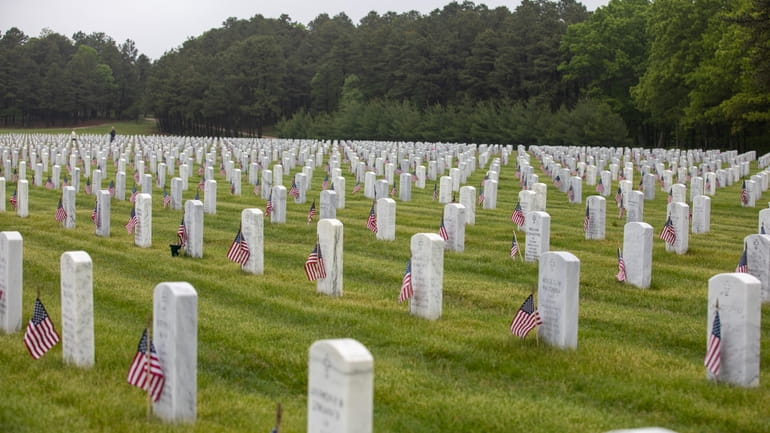WWII soldier killed in German minefield to be laid to rest at Calverton National Cemetery

Veteran headstones are marked with American flags at Calverton National Cemetery Annual Memorial Day Flag Placement. The remains of a World War II soldier who had gone unidentified for decades will be buried at the cemetery Oct. 10. Credit: Morgan Campbell
For 77 years, the remains of U.S. Army Sgt. Bernard J. Sweeney Jr., a casualty of World War II, went unidentified, including decades in a Belgian cemetery where he was known only by a number: X-2752.
But efforts to give him a name intensified in 2019. A few years later, government scientists identified Sweeney, who went missing in action on Dec. 16, 1944. Now, the owner of Alexander-Rothwell Funeral Home in Wading River said he considers it the highest honor to be able to finally bury the remains of the 22-year-old who perished in a German minefield, at Calverton National Cemetery.
"The highest honor they can give to any fallen soldier is to be laid to rest in any national cemetery," said Ken Rothwell, owner of the funeral home, which is located near the Wading River cemetery. Rothwell said the Army asked if the funeral home could assist them "in bringing Sergeant Sweeney home." But Rothwell said, "We agreed to donate all of our services in an effort to bring him home in the most dignified and honored way possible."
Rothwell said additional donations have been made by the Riverhead VFW, Riverhead Elks Lodge and Riverhead Rotary to help pay the cost of a horse-drawn caisson sent from Connecticut.
WHAT TO KNOW
- The remains of U.S. Army Sgt. Bernard J. Sweeney Jr. will be buried at Calverton National Cemetery in Wading River after decades in which he was identified only by a number.
- Sweeney, a casualty of World War II, was killed in battle in Germany.
- Costs for his burial with military honors were covered by a Wading River funeral home, along with other veterans' groups.
"I’ve been a funeral director for almost 30 years, and this will be the one of the most profound funeral services that we’ve ever performed," Rothwell added.
The funeral for Sweeney is scheduled to take place Oct. 10 at noon. In addition to the horse-drawn caisson that will carry his coffin from the funeral home to the cemetery, there will be a riderless horse in tribute to the fallen soldier.
The Warrior Ranch Foundation is providing its quarter horse, Cody, to serve as the riderless horse, led behind the caisson wearing an empty saddle with the rider's boots reversed in the stirrups, indicating the warrior will never ride again.
"We are humbled and proud to help in this procession," said Eileen Shanahan, president of the Calverton-based Warrior Ranch Foundation, which provides equine-assisted learning therapy for veterans and first responders. "This is the first time we are participating in a procession for a fallen hero." She said U.S. Army Capt. Michael Keegan will lead Cody in the procession.
Sweeney had no surviving immediate family or next of kin, officials said. But Rothwell said efforts were being made to make sure there will be many on hand to show respect and honor Sweeney along the route from the funeral home to the cemetery. "This will take a village to lay a soldier to rest."
"We have reached out to the local American Legion, local VFW and Elks Lodge association, Rotary Club, Moose Lodge," as well as local churches "in case people want to attend," Rothwell said.
Veterans and representatives of fire and police departments, government officials and others were expected
While he was from Waterbury, Connecticut, according to a news release on the website of the Defense POW/MIA Accounting Agency (known as DPAA), Sweeney enlisted in New York City, according to Army officials. So the closest national cemetery was the one at Calverton, which is why Rothwell said Army officials reached out to his funeral home.
Sweeney's long journey "home" involved decades of efforts to identify his remains, according to official accounts.
Sweeney was reported as missing while assigned to Company 1, 330th Infantry Regiment, 83rd Division, according to the DPAA. His unit was fighting German forces in the Hürtgen Forest, the DPAA said.
Following the end of the war, the American Graves Registration Command conducted several investigations in the Hürtgen Forest area between 1946 and 1950, but still didn't find Sweeney's remains. "He was declared nonrecoverable in November 1951," the DPAA said.
Years later, a DPAA historian determined that a set of unidentified remains, designated X-2752 Neuville that had been recovered in a minefield north of Kleinhau, Germany in 1946 might be Sweeney's. The remains were disinterred from the Ardennes American Cemetery in Neuville-en-Condroz, Belgium, in 2019 and sent to the DPAA laboratory at Offutt Air Force Base in Nebraska, where they were identified as Sweeney's in 2021.
To identify the remains, DPAA scientists used dental and anthropological analysis along with circumstantial evidence, mitochondrial DNA and Y-chromosome DNA analysis.
Rothwell said he expects to receive Sweeney's remains next week.
"The military’s goal is to return every soldier home," he said.
Feral cat found with rabies . . . Piano Man's last show . . . Travel to Block Island . . . Olympics opening ceremony
Feral cat found with rabies . . . Piano Man's last show . . . Travel to Block Island . . . Olympics opening ceremony

